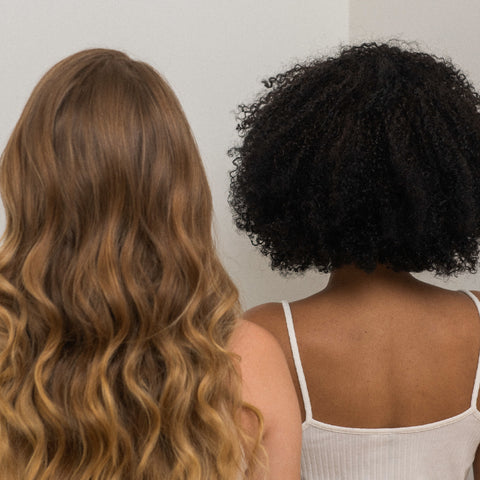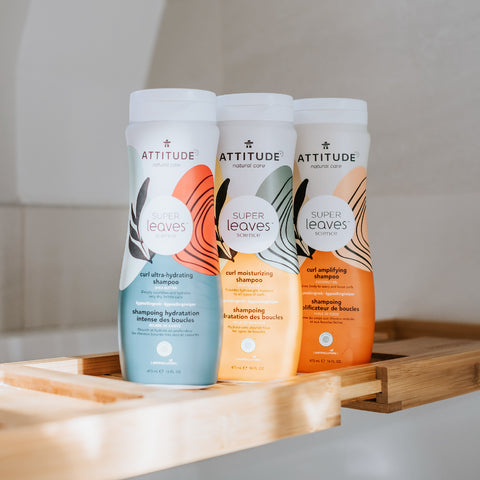Find your curly hair type
People with curly hair are often envied: their curls give them a distinct personality and an unmistakable presence that turns heads. But it would be wrong to believe that sublime curly hair type does not come with its very personal share of problems!
We are all unique, that's what makes us so charming and there are as many hair styles as there are human beings. Knowing what hair type we have can help us take care of it, keep it healthy, and bring it to its full potential with the proper hair care routine.
This is why hair type classification systems have been invented, such as the one popularized by Andre Walker, which divides hair into four categories, three of which regroup the different types of waves and curls and redivide them into subcategories.
In order to demystify curly hair types and understand its very specific needs, we will focus on these three main categories, namely wavy, curly and coily hair, by explaining what differentiates them, what defines them and what their needs are. But first, let's see what hair is made of, so we can understand it better.

What is hair made of?
The hair fiber is made up of three different parts: the cuticle, the cortex and the medulla. The cuticle is a set of layers that cover the hair, forming an outer shell and repelling water. The cortex looks like a cell and contains keratin and melanin, which determine the texture and color of the hair. Finally, the medulla is an open area in the center of the fiber, which is not always present.
Type 2 curly hair type: waves

Type two hair is often flat near the root, and wavier near the ends. The sebum is therefore easily distributed near the scalp, but does not travel evenly to the ends, which means that they tend to be drier and sometimes brittle. When wavy hair is thin, it is easy to style, but the task is more difficult if it is thick.
Wavy hair therefore needs more body and definition, in order to harmonize the distribution of sebum, restore volume at the root and define the natural curl. A shampoo and a conditioner that amplifies the curls are advised: these will add shine and structure to the hair.
Type 3 curly hair type: curly hair

Type 3 hair often has an shape, varying between looser and tighter curls, giving it volume and dimension. Since sebum is difficult to distribute from root to tip, this type of hair can be fragile and brittle, despite its robust appearance.
Curly hair needs hydration and elasticity in order to improve its resistance and strengthen it. To define the curls without weighing them down, use a shampoo and a conditioner which provide light hydration.
Type 4 curly hair type: tight curls & coils

Type 4 hair has a twisty pattern or a "Z" shape that shrinks when wet, as it has fewer cuticles than other types of hair. High density tight coiled curls are the most fragile of all and tend to suffer from severe dryness.
That's why coily hair needs to be nourished with a shampoo that will deep cleanse without dehydrating it and a rich moisturizing conditioner that will keep it supple and healthy. It is also important to get the right styling tools, such as detangling combs specially designed for this type of hair, to avoid breaking them and to facilitate disentangling.
Tips for all types of curly hair
Regardless of your specific curly hair type, here are five tips to apply to all textured hair:
-
Don't use a towel to dry your hair.
Do not wring out or rub the hair with a towel after washing: gently twist it in the shower to remove excess water instead.
-
Use a diffuser.
If you blow dry your hair, use a diffuser, in order to distribute the heat more evenly and to avoid overheating the hair.
-
Only detangle your hair with wide-toothed comb.
Do not brush your hair or detangle it when it’s dry: instead, use a wide-toothed comb when it is wet and coated with conditioner.
-
Always verify your hair care products ingredients.
Pay close attention to the ingredient list of your shampoos, conditioners and other hair care products: some ingredients can harm the hair structure and even your health. To give you a hand, you can rely on the EWG Skin Deep database, which will help you find healthy and safe products.
-
Sleep with a satin pillowcase.
Sleeping with a satin pillowcase or nightcap can help prevent tangled curls and hair breakage while you sleep.
Of course, there is plenty of other tips and tricks for pampering and caring for our curls. With the advent of social media, lush, natural hair has become popular ... and we're happy about that, because it's so much easier to share advice now! The bottom line remains the same: having great shampoo and conditioner that is natural and contain ingredients that are right for your hair type is the first step to healthy hair.
That’s why we’re so proud to launch our shampoos and conditioners for curly hair, in three variations to meet all the needs of different types of textured hair. Whether your hair is wavy, curly or frizzy, you will find the ideal natural, vegan and ECOLOGO certified hair products to create your own personalized routine.
We hope this little guide has helped you better understand curly hair types. To help you find the ideal hair care routine, we’ve also created a 7-questions quiz to help you find the right products. Take the test!
